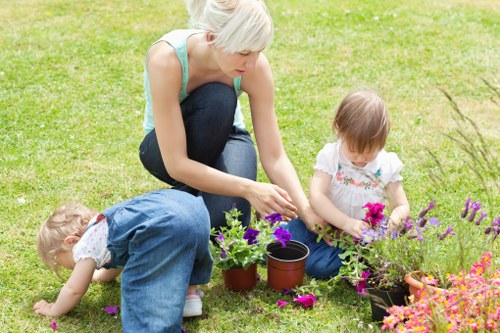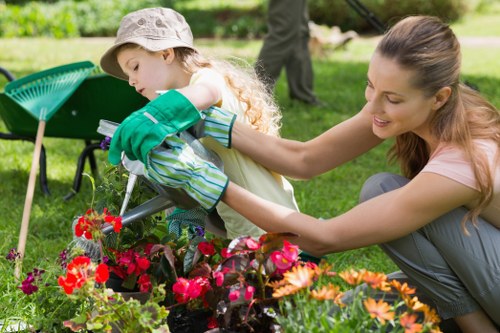Lawn Turf Installation in Garden Maintenance

Introduction to Lawn Turf Installation
Maintaining a beautiful garden requires dedication, effort, and the right materials. One of the most effective ways to achieve a lush, green lawn is through professional lawn turf installation. Whether you're starting from scratch or renovating an existing space, understanding the process and benefits can help you make informed decisions for your garden maintenance.
Lawn turf installation offers a quick and reliable solution to establish a healthy and vibrant lawn. Unlike seed planting, which can take time to germinate and grow, turf provides an instant green cover, enhancing the aesthetic appeal of your garden almost immediately.
In this article, we will explore the essential aspects of lawn turf installation, including preparation, installation techniques, maintenance tips, and the advantages of choosing turf over other methods. By the end, you'll have a comprehensive understanding of how to achieve and maintain a stunning lawn that adds value and beauty to your property.

Benefits of Choosing Lawn Turf
Opting for lawn turf installation comes with numerous benefits that make it a preferred choice for many homeowners and gardeners:
- Instant Gratification: Turf provides an immediate green lawn, eliminating the waiting period associated with seed-based lawns.
- Durability: Well-installed turf is resilient to foot traffic, weather conditions, and pests, ensuring a long-lasting lawn.
- Weed Control: Quality turf comes with fewer weed seeds, reducing the need for herbicides and maintenance.
- Soil Erosion Prevention: Turf acts as a natural barrier, preventing soil erosion and promoting soil health.
- Customization: Available in various grass types and textures, turf allows for customization to suit your specific needs and preferences.
Understanding these benefits underscores why lawn turf installation is a valuable investment for both new and existing gardens.
Additionally, turf installation can significantly enhance the overall value of your property. A well-maintained lawn is a key feature that potential buyers look for, making it an essential aspect of property aesthetics and marketability.

Preparing Your Garden for Turf Installation
Proper preparation is crucial for the success of your lawn turf installation. Neglecting any step can lead to poor growth, uneven surfaces, and increased maintenance needs. Here's a step-by-step guide to preparing your garden:
- Soil Testing: Begin by testing your soil's pH and nutrient levels. This will help determine if any amendments are needed to create an optimal environment for your turf.
- Clearing the Area: Remove any existing vegetation, rocks, and debris from the installation site. This ensures a smooth and even surface for laying the turf.
- Leveling the Ground: Use a rake or a leveling tool to ensure the soil surface is even. This prevents uneven growth and facilitates proper drainage.
- Soil Amendment: Based on your soil test results, add necessary amendments such as compost, sand, or fertilizer to enhance soil quality and fertility.
- Tilling the Soil: Loosen the soil to a depth of at least 6 inches using a tiller. This promotes root penetration and healthy turf growth.
- Final Grading: Grade the soil to ensure it slopes away from buildings and structures, preventing water pooling and promoting proper drainage.
Taking the time to meticulously prepare your garden sets the foundation for a thriving and resilient lawn.

Choosing the Right Turf for Your Garden
Selecting the appropriate type of turf is vital for achieving the desired appearance and functionality of your lawn. Consider the following factors when choosing turf:
- Climate: Different grass types thrive in varying climates. Choose a turf that is well-suited to your region's temperature and precipitation patterns.
- Sunlight Exposure: Assess the amount of sunlight your garden receives. Some grasses require full sun, while others can tolerate shade.
- Usage: Determine how the lawn will be used. High-traffic areas may require more durable grass varieties.
- Maintenance Requirements: Consider the maintenance level you are willing to commit to. Some turfs require more frequent mowing and watering than others.
- Soil Type: Match the turf to your soil type to ensure compatibility and optimal growth.
Popular turf varieties include Bermuda grass, Zoysia grass, Kentucky Bluegrass, and Fescue. Each type has its unique characteristics, so it's essential to choose one that aligns with your garden's specific needs and your personal preferences.
Top Turf Varieties for Garden Maintenance
Here are some of the top turf varieties commonly used in garden maintenance:
- Bermuda Grass: Ideal for warm climates, Bermuda grass is durable and heat-tolerant, making it perfect for sunny gardens with high foot traffic.
- Kentucky Bluegrass: Suited for cooler climates, Kentucky Bluegrass offers a lush, dense lawn that is soft underfoot and aesthetically pleasing.
- Zoysia Grass: This versatile grass thrives in both sun and partial shade, providing a fine texture and excellent drought resistance.
- Fescue: Known for its shade tolerance and low maintenance requirements, Fescue is a great choice for gardens with varying light conditions.

The Turf Installation Process
Step-by-Step Guide to Installing Lawn Turf
Installing lawn turf involves several key steps to ensure a successful and enduring lawn. Follow this step-by-step guide to achieve optimal results:
- Planning and Measurement: Measure your garden area accurately to determine the amount of turf required. Planning helps in budgeting and minimizes waste.
- Delivery and Storage: Arrange for the timely delivery of turf rolls. Store the turf in a shaded, cool area to prevent drying out before installation.
- Marking the Area: Use stakes and string to outline the installation area, ensuring precise placement and straight edges.
- Soil Preparation: Refer to the preparation steps outlined earlier to ensure the soil is ready for turf installation.
- Rolling Out the Turf: Begin laying the turf along the longest straight edge of the garden. Ensure each roll is tightly butted against the next to avoid gaps.
- Trimming and Fitting: Use a sharp knife or turf cutter to trim excess edges, ensuring a neat fit around obstacles such as trees and pathways.
- Seaming: Stitch the seams with turf nails or staples to secure the edges and prevent movement.
- Watering: Immediately water the newly installed turf thoroughly to help the roots establish and settle into the soil.
- Initial Maintenance: Keep the turf moist for the first few weeks, avoiding heavy foot traffic to promote healthy root growth.
Following these steps meticulously ensures that your lawn turf installation is successful, leading to a resilient and attractive lawn.
Common Installation Mistakes to Avoid
While installing lawn turf, certain mistakes can compromise the health and appearance of your lawn. Avoid the following common pitfalls:
- Poor Soil Preparation: Skipping soil preparation can lead to uneven growth and weak root systems.
- Incorrect Turf Selection: Choosing a turf type that doesn't match your climate or garden conditions can result in poor growth and high maintenance.
- Improper Installation: Failing to lay the turf tightly can create gaps that allow weeds to grow.
- Insufficient Watering: Not watering the turf adequately during the establishment phase can hinder root development.
- Heavy Foot Traffic Early On: Excessive use of the lawn before the turf has rooted can damage the installation.

Post-Installation Care and Maintenance
Proper care after installing lawn turf is essential to ensure its longevity and vitality. Here are some key maintenance tips:
Watering Schedule
Maintaining an appropriate watering schedule is critical during the initial stages of turf establishment:
- First Week: Water the turf twice daily to keep the soil consistently moist.
- Second Week: Gradually reduce watering to once daily.
- Third Week Onwards: Transition to watering 2-3 times per week, depending on weather conditions and soil type.
- Deep Soaking: Encourage deep root growth by watering thoroughly but infrequently.
Avoid overwatering, which can lead to fungal diseases and shallow root systems.
Mowing Practices
Proper mowing encourages healthy turf growth and maintains an attractive appearance:
- First Mow: Wait until the turf has established and reached about 3 inches in height before the first mow.
- Mowing Height: Keep the grass at an optimal height, typically between 2-3 inches, depending on the grass type.
- Regular Mowing: Mow frequently enough to remove no more than one-third of the grass blade's height at a time.
- Sharp Blades: Ensure mower blades are sharp to prevent tearing the grass, which can lead to disease.
Consistent mowing practices contribute to a dense and healthy lawn.
Fertilizing and Weed Control
Fertilizing provides essential nutrients for turf growth, while weed control maintains its purity:
- Fertilizing: Apply a balanced fertilizer 4-6 weeks after installation, followed by seasonal applications based on soil test results.
- Weed Control: Use pre-emergent herbicides to prevent weed seeds from germinating. For existing weeds, opt for selective herbicides that target unwanted plants without harming the turf.
- Organic Options: Consider organic fertilizers and weed control methods for an environmentally friendly approach.
Regular fertilization and weed management are key to maintaining a pristine lawn.

Advanced Maintenance Techniques
Aeration
Aerating your lawn involves perforating the soil to allow air, water, and nutrients to penetrate the roots. This promotes healthy growth and reduces soil compaction:
- Frequency: Aerate your lawn once or twice a year, typically in the spring or fall.
- Method: Use a core aerator to remove plugs of soil from the lawn.
- Benefits: Enhanced root development, improved drainage, and increased nutrient absorption.
Overseeding
Overseeding involves spreading grass seed over an existing lawn to improve density and fill in bare spots:
- When to Overseed: Best done in the fall for cool-season grasses and in the spring for warm-season grasses.
- Preparation: Mow the lawn short, aerate the soil, and ensure good seed-to-soil contact.
- Execution: Spread the seed evenly and water regularly until germination.
Pest and Disease Management
Protecting your lawn from pests and diseases is crucial for its health:
- Regular Inspection: Check for signs of pests or disease regularly.
- Integrated Pest Management: Use a combination of cultural, biological, and chemical methods to control pests.
- Prompt Action: Address issues immediately to prevent them from spreading.
Effective pest and disease management ensures a resilient and healthy lawn.

Cost Considerations for Turf Installation
Budgeting for lawn turf installation involves several factors. Understanding these can help you manage costs effectively:
Factors Influencing Cost
- Garden Size: Larger areas require more turf, increasing material costs.
- Soil Condition: Poor soil may need amendments or additional preparation, adding to the overall expense.
- Turf Type: Premium turf varieties typically cost more than standard options.
- Labor Costs: Professional installation can vary based on location and the complexity of the project.
- Additional Materials: Items such as fertilizers, weed control products, and equipment rentals can impact the total cost.
Budgeting Tips
- Get Multiple Quotes: Obtain estimates from several suppliers or contractors to find the best price.
- Plan for Extras: Include a contingency fund for unexpected expenses.
- DIY Installation: If you have the necessary skills and equipment, installing the turf yourself can save on labor costs.
- Buy in Bulk: Purchasing larger quantities of turf can sometimes lead to discounts.
Careful planning and budgeting help ensure that your turf installation project stays within financial expectations.
Long-Term Investment
While the initial cost of turf installation might be higher than other lawn establishment methods, the long-term benefits often justify the expense:
- Low Maintenance: Turf requires less watering and fertilizing compared to seed-based lawns.
- Durability: A well-installed turf can last many years with proper care, reducing the need for frequent replacements.
- Property Value: A beautiful lawn enhances curb appeal and can increase property value.
Considering these factors highlights the turf installation as a cost-effective and valuable investment for your garden.

Environmental Impact of Turf Installation
Choosing turf installation can have both positive and negative environmental impacts. It's essential to consider these aspects to make eco-friendly decisions:
Positive Impacts
- Carbon Sequestration: Healthy lawns absorb carbon dioxide, helping to mitigate climate change.
- Air Quality Improvement: Grass acts as a natural air filter, trapping dust and pollutants.
- Temperature Regulation: Turf lawns can help reduce the urban heat island effect by cooling the surrounding area.
- Water Filtration: Grass helps in filtering rainwater, reducing runoff and preventing water pollution.
Negative Impacts
- Water Usage: Maintaining lush turf can require significant watering, contributing to water scarcity concerns.
- Pesticide and Fertilizer Use: The application of chemicals for turf maintenance can lead to soil and water contamination.
- Biodiversity Reduction: Monoculture grass lawns can minimize habitat diversity for insects and other wildlife.
Eco-Friendly Practices
To minimize the environmental impact of turf installation, consider implementing the following sustainable practices:
- Choose Native Grass Varieties: Native grasses are better adapted to local conditions and require less water and maintenance.
- Efficient Watering: Use drip irrigation systems and rainwater harvesting to reduce water usage.
- Organic Maintenance: Opt for organic fertilizers and natural pest control methods to protect the environment.
- Promote Biodiversity: Incorporate flowering plants and shrubs around the lawn to support a diverse ecosystem.
Adopting these environmentally friendly practices ensures that your lawn contributes positively to the ecosystem.

Choosing a Professional Turf Installer
Selecting the right professional for your turf installation is crucial for achieving the best results. Here are some tips to help you make an informed choice:
Research and Recommendations
- Seek Recommendations: Ask friends, family, or neighbors for referrals to reputable turf installers.
- Check Reviews: Look for online reviews and testimonials to gauge the quality of service offered by different contractors.
- Verify Credentials: Ensure the installer is licensed, insured, and has relevant experience in turf installation.
Evaluate Experience and Expertise
Experienced turf installers are more likely to deliver high-quality results. Consider the following:
- Portfolio: Review the installer's previous projects to assess their workmanship and attention to detail.
- Knowledge: An expert installer should be knowledgeable about different turf varieties, soil preparation, and maintenance practices.
- Customization: Choose an installer who can tailor the installation process to meet your specific garden requirements.
Get Detailed Quotes
Obtain comprehensive quotes from multiple installers to compare services and prices:
- Breakdown of Costs: Ensure the quote includes all aspects of the installation, such as soil preparation, turf delivery, labor, and any additional materials.
- Warranty: Inquire about warranties or guarantees offered on the turf and installation work.
- Timeline: Confirm the expected timeline for project completion to align with your schedule.
Choosing a professional installer with the right credentials and a solid reputation ensures a successful turf installation project.
Finalizing the Agreement
Once you've selected a turf installer, ensure that all terms are clearly defined in a written agreement:
- Scope of Work: Clearly outline the tasks to be performed, including preparation, installation, and any post-installation services.
- Payment Terms: Define the payment schedule, including deposits and final payments.
- Completion Date: Specify the expected start and finish dates for the project.
- Warranty Details: Include information about any guarantees on the turf or workmanship.
A well-documented agreement helps prevent misunderstandings and ensures that both parties are aligned on project expectations.
Conclusion
Investing in lawn turf installation is a surefire way to achieve a stunning and low-maintenance garden. From the initial preparation to the final installation and ongoing maintenance, each step plays a vital role in ensuring the health and beauty of your lawn.
By understanding the benefits of turf, selecting the right variety, and following proper installation and care practices, you can enjoy a vibrant green lawn that enhances your outdoor space and adds value to your property.
Whether you're a gardening enthusiast or a homeowner looking to improve your garden, professional lawn turf installation offers a practical and rewarding solution. Embrace the process, commit to regular maintenance, and reap the rewards of a lush and resilient lawn for years to come.
Take the Next Step
Ready to transform your garden with a beautiful turf lawn? Contact us today to schedule your lawn turf installation and take the first step towards a greener, more vibrant outdoor space.
Frequently Asked Questions
Get In Touch With Us.
Please fill out the form below to send us an email and we will get back to you as soon as possible.